Maternal Attachment and Maternal Behavior: The Role of Maternal Affect
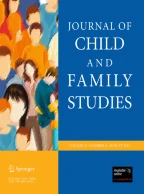
Previous research has demonstrated the importance of maternal attachment style to children’s well-being, but the mediators of this relationship are understudied. Parental affect is one potential mediator. Previous research has documented the relationship between parental attachment and parental affect, and between parental affect and parental behaviors, but maternal affect has not yet been established as a mechanism through which attachment influences parenting behaviors. We hypothesized that parental affect would mediate the relationship between parental attachment and parental behaviors in mothers. A community-based sample of 132 mothers of at least one child between the ages of 2 and 12 completed questionnaires on maternal attachment, maternal affect, and parenting behaviors. Confirming previous research, significant relationships were found between maternal attachment and affect, maternal attachment and parenting behaviors, and maternal affect and parenting behaviors. As predicted, maternal affect mediated the relationship between maternal attachment style and parenting behavior. Specifically, positive affect mediated the relationship between maternal attachment and nurturance, secure base, safe haven, and companionship parenting behaviors. Negative affect mediated the relationship between maternal attachment and nurturance. Implications include acknowledging differential roles of positive and negative affect in their influence on parental behaviors.
Highlights
- Maternal affect may mediate the relation between parental attachment and parenting behaviors.
- Positive affect and negative affect differ in terms of how they influence the relation between parental attachment and parenting behaviors.
- Established relations between negative affect and parental behaviors in clinical populations are similar to those in community samples.
- The indirect relation between parental attachment and parenting behaviors via maternal affect is significant.
- Positive affect is also related to parental behaviors in a community sample.
This is a preview of subscription content, log in via an institution to check access.
Access this article
Subscribe and save
Springer+ Basic
€32.70 /Month
- Get 10 units per month
- Download Article/Chapter or eBook
- 1 Unit = 1 Article or 1 Chapter
- Cancel anytime
Buy Now
Price includes VAT (France)
Instant access to the full article PDF.
Rent this article via DeepDyve
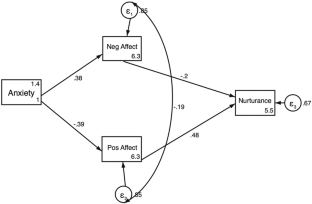
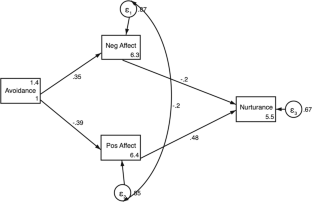
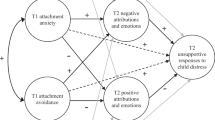
Mothers’ Attachment Style Predicts Response to Child Distress: The Role of Maternal Emotions and Attributions
Article 26 December 2022
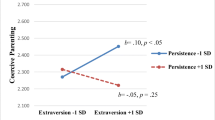
The relationship between negative parenting and child and maternal temperament
Article 31 May 2019
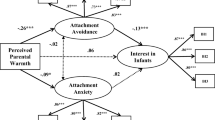
Mediation effect of adult attachment orientations between perceived parental warmth and the preference for infants
Article 03 August 2019
References
- Adam, E. K., Gunnar, M. R., & Tanaka, A. (2004). Adult attachment, parent emotion, and observed parenting behavior: Mediator and moderator models. Child Development, 75(1), 110–122. https://doi.org/10.1111/j.1467-8624.2004.00657. ArticlePubMedGoogle Scholar
- Alford, D. J., Lyddon, W. J., & Schreiber, R. (2006). Adult attachment and working models of emotion. Counselling Psychology Quarterly, 19(1), 45–56. https://doi.org/10.1080/09515070600673687. ArticleGoogle Scholar
- Arellano, P. A. E., Harvey, E. A., & Thakar, D. A. (2012). A longitudinal study of the relation between depressive symptomatology and parenting practices. Family Relations: An Interdisciplinary Journal of Applied Family Studies, 61(2), 271–282. https://doi.org/10.1111/j.1741-3729.2011.00694. ArticleGoogle Scholar
- Ata, S., & Yağan Güder, S. (2020). Parents’ attachment to their children and their level of interest in them in predicting children’s self-concepts. Early Child Development and Care, 190(2), 161–174. https://doi.org/10.1080/03004430.2018.1461092. ArticleGoogle Scholar
- Aviezer, O., Sagi, A., Joels, T., & Ziv, Y. (1999). Emotional availability and attachment representations in kibbutz infants and their mothers. Developmental Psychology, 35(3), 811–821. https://doi.org/10.1037/0012-1649.35.3.811. ArticlePubMedGoogle Scholar
- Baron, R. M., & Kenny, D. A. (1986). The moderator–mediator variable distinction in social psychological research: Conceptual, strategic, and statistical considerations. Journal of Personality and Social Psychology, 51(6), 1173–1182. https://doi.org/10.1037/0022-3514.51.6.1173. ArticlePubMedGoogle Scholar
- Baumrind, D. (1971). Current patterns of parental authority. Developmental Psychology, 4(1, Pt.2), 1–103. https://doi.org/10.1037/h0030372. ArticleGoogle Scholar
- Bowlby, J. (1982). Attachment and loss. Basic Books.
- Brennan, K. A., Clark, C. L., & Shaver, P. R. (1998). Self-report measurement of adult attachment: An integrative overview. In J. A. Simpson & W. S. Rholes (Eds.), Attachment theory and close relationships (pp. 46–76). The Guilford Press.
- Cameron, J. J., Finnegan, H., & Morry, M. M. (2012). Orthogonal dreams in an oblique world: A meta-analysis of the association between attachment anxiety and avoidance. Journal of Research in Personality, 46(5), 472–476. https://doi.org/10.1016/j.jrp.2012.05.001. ArticleGoogle Scholar
- Cohn, D. A., Cowan, P. A., Cowan, C. P., & Pearson, J. (1992). Mothers’ and fathers’ working models of childhood attachment relationships, parenting styles, and child behavior. Development and Psychopathology, 4(3), 417–431. https://doi.org/10.1017/S0954579400000870. ArticleGoogle Scholar
- Cooke, J. E., Kochendorfer, L. B., Stuart-Parrigon, K. L., Koehn, A. J., & Kerns, K. A. (2019). Parent–child attachment and children’s experience and regulation of emotion: A meta-analytic review. Emotion, 19(6), 1103–1126. https://doi.org/10.1037/emo0000504. ArticlePubMedGoogle Scholar
- Crowell, J. A., & Feldman, S. S. (1988). Mothers’ internal models of relationships and children’s behavioral and developmental status: A study of mother-child interaction. Child Development, 59(5), 1273–1285. https://doi.org/10.2307/1130490. ArticlePubMedGoogle Scholar
- Crowell, J. A., & Feldman, S. S. (1991). Mothers’ working models of attachment relationships and mother and child behavior during separation and reunion. Developmental Psychology, 27(4), 597–605. https://doi.org/10.1037/0012-1649.27.4.597. ArticleGoogle Scholar
- Crowell, J. A., O’Connor, E., Wollmers, G., Sprafkin, J., & Rao, U. (1991). Mothers’ conceptualizations of parent-child relationships: Relation to mother-child interaction and child behavior problems. Development and Psychopathology, 3(4), 431–444. https://doi.org/10.1017/S0954579400007616. ArticleGoogle Scholar
- Cummings, E. M., Keller, P. S., & Davies, P. T. (2005). Towards a family process model of maternal and paternal depressive symptoms: Exploring multiple relations with child and family functioning. Journal of Child Psychology and Psychiatry, 46(5), 479–489. https://doi.org/10.1111/j.1469-7610.2004.00368. ArticlePubMedGoogle Scholar
- Downey, G., & Coyne, J. C. (1990). Children of depressed parents: An integrative review. Psychological Bulletin, 108(1), 50–76. https://doi.org/10.1037/0033-2909.108.1.50. ArticlePubMedGoogle Scholar
- Edelstein, R. S., Alexander, K. W., Shaver, P. R., Schaaf, J. M., Quas, J. A., Lovas, G. S., & Goodman, G. S. (2004). Adult attachment style and parental responsiveness during a stressful event. Attachment & Human Development, 6(1), 31–52. https://doi.org/10.1080/146167303100001659584. ArticleGoogle Scholar
- Elgar, F. J., Mills, R. S. L., McGrath, P. J., Waschbusch, D. A., & Brownridge, D. A. (2007). Maternal and paternal depressive symptoms and child maladjustment: The mediating role of parental behavior. Journal of Abnormal Child Psychology, 35(6), 943–955. https://doi.org/10.1007/s10802-007-9145-0. ArticlePubMedGoogle Scholar
- Fairchild, A. J., & Finney, S. J. (2006). Investigating validity evidence for the Experiences in Close Relationships-Revised Questionnaire. Educational and Psychological Measurement, 66(1), 116–135. https://doi.org/10.1177/0013164405278564. ArticleGoogle Scholar
- Feng, X., Shaw, D. S., Kovacs, M., Lane, T., O’Rourke, E. F., & Alarcon, J. H. (2008). Emotion regulation in preschoolers: The roles of behavioral inhibition, maternal affective behavior, and maternal depression. Journal of Child Psychology and Psychiatry, 49, 132–141. https://doi.org/10.1111/j.1469-7610.2007.01828.x. ArticlePubMedGoogle Scholar
- Fiedler, K., Schott, M., & Meiser, T. (2011). What mediation analysis can (not) do. Journal of Experimental Social Psychology, 47, 1231–1236. https://doi.org/10.1016/j.jesp.2011.05.007. ArticleGoogle Scholar
- Fraley, R. C., & Waller, N. G. (1998). Adult attachment patterns: A test of the typological model. In J. A. Simpson & W. S. Rholes (Eds.), Attachment theory and close relationships (pp. 77–114). Guilford Press.
- Fraley, R. C., Waller, N. G., & Brennan, K. A. (2000). An item response theory analysis of self-report measures of adult attachment. Journal of Personality and Social Psychology, 78(2), 350–365. https://doi.org/10.1037/0022-3514.78.2.350. ArticlePubMedGoogle Scholar
- Fredrickson, B. L. (2001). The role of positive emotions in positive psychology: The broaden-and-build theory of positive emotions. American Psychologist, 56(3), 218–226. ArticlePubMedGoogle Scholar
- Gentzler, A. L., Ramsey, M. A., & Black, K. R. (2015). Mothers’ attachment styles and their children’s self-reported security, as related to maternal socialization of children’s positive affect regulation. Attachment & Human Development, 17(4), 376–398. https://doi.org/10.1080/14616734.2015.1055507. ArticleGoogle Scholar
- Green, B. L., Furrer, C., & McAllister, C. (2007). How do relationships support parenting? Effects of attachment style and social support on parenting behavior in an at-risk population. American Journal of Community Psychology, 40(1–2), 96–108. https://doi.org/10.1007/s10464-007-9127-y. ArticlePubMedGoogle Scholar
- Hayes, A. F. (2009). Beyond Baron and Kenny: Statistical mediation analysis in the new millennium. Communication Monographs, 76(4), 408–420. https://doi.org/10.1080/03637750903310360. ArticleGoogle Scholar
- Jones, J. D., & Cassidy, J. (2014). Parental attachment style: Examination of links with parent secure base provision and adolescent secure base use. Attachment & Human Development, 16(5), 437–461. https://doi.org/10.1080/14616734.2014.921718. ArticleGoogle Scholar
- Jones, J. D., Cassidy, J., & Shaver, P. R. (2015). Parents’ self-reported attachment styles: A review of links with parenting behaviors, emotions, and cognitions. Personality and Social Psychology Review, 19(1), 44–76. https://doi.org/10.1177/1088868314541858. ArticlePubMedGoogle Scholar
- Jouriles, E. N., Murphy, C. M., & O’Leary, K. D. (1989). Effects of maternal mood on mother-son interaction patterns. Journal of Abnormal Child Psychology, 17(5), 513–525. https://doi.org/10.1007/BF00916510. ArticlePubMedGoogle Scholar
- Kline, R. B. (1998). Principles and practice of structural equation modeling. Guilford Press.
- Koehn, A. J., & Kerns, K. A. (2018). Parent-child attachment: Meta-analysis of associations with parenting behaviors in middle childhood and adolescence. Attachment & Human Development, 20(4), 378–405. https://doi.org/10.1080/14616734.2017.1408131. ArticleGoogle Scholar
- Lovejoy, M. C., Graczyk, P. A., O’Hare, E., & Neuman, G. (2000). Maternal depression and parenting behavior: A meta-analytic review. Clinical Psychology Review, 20(5), 561–592. https://doi.org/10.1016/S0272-7358(98)00100-7. ArticlePubMedGoogle Scholar
- Main, M., Kaplan, N., & Cassidy, J. (1985). Security in infancy childhood, and adulthood: A move to the representational level. In I. Bretherton & E. Waters (Eds.), Growing points of attachment theory and research (pp. 66–104). Chicago, IL: University of Chicago Press.
- Mikulincer, M. (1998). Adult attachment style and individual differences in functional versus dysfunctional experiences of anger. Journal of Personality and Social Psychology, 74(2), 513–524. https://doi.org/10.1037/0022-3514.74.2.513. ArticlePubMedGoogle Scholar
- Molero, F., Shaver, P. R., Fernández, I., & Recio, P. (2017). Attachment insecurities, life satisfaction, and relationship satisfaction from a dyadic perspective: The role of positive and negative affect. European Journal of Social Psychology, 47(3), 337–347. https://doi.org/10.1002/ejsp.2276. ArticleGoogle Scholar
- Moreira, H., & Canavarro, M. C. (2015). Individual and gender differences in mindful parenting: The role of attachment and caregiving representations. Personality and Individual Differences, 87, 13–19. https://doi.org/10.1016/j.paid.2015.07.021. ArticleGoogle Scholar
- Perry, M. A., & Fantuzzo, J. W. (2010). A multivariate investigation of maternal risks and their relationship to low-income, preschool children’s competencies. Applied Developmental Science, 14, 1–17. https://doi.org/10.1080/10888690903510281. ArticleGoogle Scholar
- Power, T. G. (2002). Parenting dimensions inventory (PDI—S): A research manual. Unpublished manuscript. Pullman, WA: Washington State University. Google Scholar
- Rholes, W. S., Simpson, J. A., & Blakely, B. S. (1995). Adult attachment styles and mothers’ relationships with their young children. Personal Relationships, 2(1), 35–54. https://doi.org/10.1111/j.1475-6811.1995.tb00076.x. ArticleGoogle Scholar
- Roisman, G. I., Holland, A., Fortuna, K., Fraley, R. C., Clausell, E., & Clarke, A. (2007). The Adult Attachment Interview and self-reports of attachment style: An empirical rapprochement. Journal of Personality and Social Psychology, 92(4), 678–697. https://doi.org/10.1037/0022-3514.92.4.678. ArticlePubMedGoogle Scholar
- Safyer, P., Volling, B. L., Schultheiss, O. C., & Tolman, R. M. (2019). Adult attachment, implicit motives, and mothers’ and fathers’ parenting behaviors. Motivation Science, 5(3), 220–234. https://doi.org/10.1037/mot0000112. ArticlePubMedGoogle Scholar
- Sagui-Henson, S. J., Armstrong, L. M., Mitchell, A. D., Basquin, C. A., & Levens, S. M. (2020). The effects of parental emotion regulation ability on parenting self-efficacy and child diet. Journal of Child and Family Studies, 29(8), 2290–2302. https://doi.org/10.1007/s10826-020-01745-x. ArticleGoogle Scholar
- Sebire, S. J., Jago, R., Wood, L., Thompson, J. L., Zahra, J., & Lawlor, D. A. (2016). Examining a conceptual model of parental nurturance, parenting practices and physical activity among 5-6 year olds. Social Science & Medicine, 148, 18–24. https://doi.org/10.1016/j.socscimed.2015.11.022. ArticleGoogle Scholar
- Selcuk, E., Günaydin, G., Sumer, N., Harma, M., Salman, S., Hazan, C., Dogruyol, B., & Ozturk, A. (2010). Self-reported romantic attachment style predicts everyday maternal caregiving behavior at home. Journal of Research in Personality, 44(4), 544–549. https://doi.org/10.1016/j.jrp.2010.05.007. ArticleGoogle Scholar
- Sibley, C. G., Fischer, R., & Liu, J. H. (2005). Reliability and validity of the Revised Experiences in Close Relationships (ECR-R) self-report measure of adult romantic attachment. Personality and Social Psychology Bulletin, 31(11), 1524–1536. https://doi.org/10.1177/0146167205276865. ArticlePubMedGoogle Scholar
- Siegel, D. J. (1999). The developing mind. Guilford Press.
- Tabachnick, B. G., & Fidell, L. S. (2001). Using multivariatesStatistics(Fourth Ed.). Allyn & Bacon.
- Tellegen, A. (1982). A brief manual for the Multidimensional Personality Questionnaire. University of Minnesota, Departmentmof Psychology.
- Teti, D. M., Gelfand, D. M., Messinger, D. S., & Isabella, R. (1995). Maternal depression and the quality of early attachment: An examination of infants, preschoolers, and their mothers. Developmental Psychology, 31(3), 364–376. https://doi.org/10.1037/0012-1649.31.3.364. ArticleGoogle Scholar
- Verschueren, K., Dossche, D., Marcoen, A., Mahieu, S., & Bakermans-Kranenburg, M. (2006). Attachment representations and discipline in mothers of young school children: An observation study. Social Development, 15(4), 659–675. https://doi.org/10.1111/j.1467-9507.2006.00363. ArticleGoogle Scholar
- Waters, E., & Cummings, M. (2000). A secure base from which to explore close relationships. Child Development, 71, 164–172. https://doi.org/10.1111/1467-8624.00130. ArticlePubMedGoogle Scholar
- Watson, D., Clark, L. A., & Tellegen, A. (1988). Development and validation of brief measures of positive and negative affect: The PANAS scales. Journal of Personality and Social Psychology, 54(6), 1063–1070. https://doi.org/10.1037/0022-3514.54.6.1063. ArticlePubMedGoogle Scholar
- Whipple, N., Bernier, A., & Mageau, G. A. (2011). A dimensional approach to maternal attachment state of mind: Relations to maternal sensitivity and maternal autonomy support. Developmental Psychology, 47(2), 396–403. https://doi.org/10.1037/a0021310. ArticlePubMedGoogle Scholar
- Wolf, E. J., Harrington, K. M., Clark, S. L., & Miller, M. W. (2013). Sample size requirements for structural equation models: An evaluation of power, bias, and solution propriety. Educational and Psychological Measurement, 76(6), 913–934. https://doi.org/10.1177/0013164413495237. ArticlePubMedGoogle Scholar
Author information
Authors and Affiliations
- Rosemead School of Psychology, Biola University, 13800 Biola Ave., La Mirada, CA, 90693, USA Jennifer A. Lindh, Josiah Tey, M. Elizabeth Lewis Hall, Tamara L. Anderson, Michele M. Willingham & David Wang
- Jennifer A. Lindh






